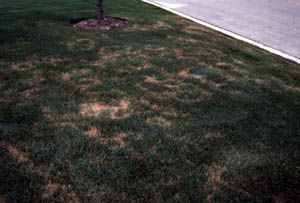Summer Patch: Bandages vs. Solutions | |
|---|---|
| May 23, 2006 | |
|
A few calls have come in lately regarding how to manage turfgrass areas damaged by summer patch last year. The obvious “quick fix” is simply to reseed or resod the damaged areas. However, it is important to understand that summer patch is a difficult and chronic disease that can not be resolved with a quick-fix approach. This article outlines the biology and management information necessary to help you lessen or prevent summer patch symptoms, instead of just applying a quick-fix “bandage.” Prior to the mid 1980s, summer patch and necrotic ring spot were part of an unexplained disease complex called Fusarium blight. We now know that necrotic ring spot (caused by the fungus Ophiosphaerella korrae) and summer patch (caused by the fungus Magnaporthe poae) are two distinct root rot diseases that can develop in the same turf area. They are widespread diseases on established Kentucky bluegrass turfs that are managed as amenity or sports turf. Other grasses susceptible to these diseases include annual bluegrass and fine-leaf fescues. Necrotic ring spot and summer patch symptoms are virtually indistinguishable, and both diseases are difficult to control. Kentucky bluegrass is generally not affected until the second or third year on newly laid sod and usually not for 4 years or more after seeding. First symptoms are scattered, light green patches, typically 2 to 6 inches in diameter. In warm to hot weather, the affected areas soon enlarge and rapidly fade to a dull reddish brown, then a light tan, and finally to a light straw color. As shown in image 060601, the patches may become elongated streaks, crescents, or roughly circular, and are 1 to 3 feet in diameter.  Within the areas of dead or stunted grass, there are often centers of green, apparently healthy grass, resulting in characteristic frog-eye or doughnut patterns. The circular patches tend to increase in size for several years (in some cases, up to 7 years) and then disappear. The dead turf area is commonly invaded by weeds. Diagnosis of this disease is difficult, and it is suggested that samples be sent to the University of Illinois Plant Clinic. Within the areas of dead or stunted grass, there are often centers of green, apparently healthy grass, resulting in characteristic frog-eye or doughnut patterns. The circular patches tend to increase in size for several years (in some cases, up to 7 years) and then disappear. The dead turf area is commonly invaded by weeds. Diagnosis of this disease is difficult, and it is suggested that samples be sent to the University of Illinois Plant Clinic.Compared to summer patch, the necrotic ring spot pathogen is more aggressive (less dependent on stressing factors), and the symptoms are often observed under cooler temperatures and in cooler regions of the United States. Summer patch can become severe when turfgrass, especially Kentucky bluegrass, is under stress and entering summer dormancy. However, initial root infections occur in the spring when soil temperatures stabilize at 65º to 70ºF at the 2-inch depth. The following stressful conditions cause summer patch to be more severe: prolonged periods of high humidity and warm to hot weather, moisture and heat stress, excessive watering, close mowing, a thatch exceeding -inch thick, soil pH above 7 or below 5, compaction, nematodes, and unbalanced applications of fertilizer. Avoid pure stands of very susceptible grass varieties. Renovation or overseeding of affected areas with species mixtures or blends of resistant varieties is the most cost-effective way to minimize these diseases. The National Turfgrass Evaluation Program Web site (http://www.ntep.org) is an excellent resource to help turf managers determine the level of disease resistance for particular varieties at various locations. The following cultural practices reduce stress and promote root development and steady growth. In particular, these practices are most beneficial: (1) core aerification, (2) increasing the mowing height as high as the turf species and use allow, (3) irrigating deeply, (4) maintaining a soil pH of 5.5 to 6.0, and (5) syringing (brief, midday sprinkling during very hot days) the turf to reduce heat stress and prevent wilt. Where cultural practices do not adequately control these diseases, a fungicide application in the autumn followed by a spring application may be justified. Each application should be made when the average soil temperature (2-inch depth under sod at 10 a.m.) reaches 68º to 70ºF. Water the turf thoroughly the day before the application. Use the highest labeled rate of the fungicide and apply with 5 gallons of water per 1,000 square feet. Because the effective fungicides (azoxystrobin, propiconazole, pyraclostrobin, triadimefon, and trifloxystrobin) cannot move down in the plant to protect root system, you need to drench the fungicide into the top 2 inches of the soil immediately after the application, using 0.5 to 1.0 inch (300 to 600 gallons) of water per 1,000 square feet. Depending on the previous and anticipated disease symptom distribution, it may be appropriate to treat high-risk areas rather than the entire turf area. As of May 18, 2006, the soil temperatures (10 a.m., 4-inch depth, under sod; see http://www.sws.uiuc.edu/warm/soiltemp.asp) range from a low of 54ºF to a high of 65ºF across Illinois. The Illinois State Water Survey Web site is an excellent resource for soil temperature data, but use caution. Recognize that data is presented for soil temperatures (min, max, 10 a.m.) at various depths and either under sod or bare soil. The fungicide application timing recommendation for summer patch is based on a 2-inch depth under sod at 10 a.m. The 2-inch soil temperature rises and falls more rapidly than the 4-inch soil temperature. Therefore, this Web site is useful for judging when to start monitoring 2-inch soil temperature at your specific location. |